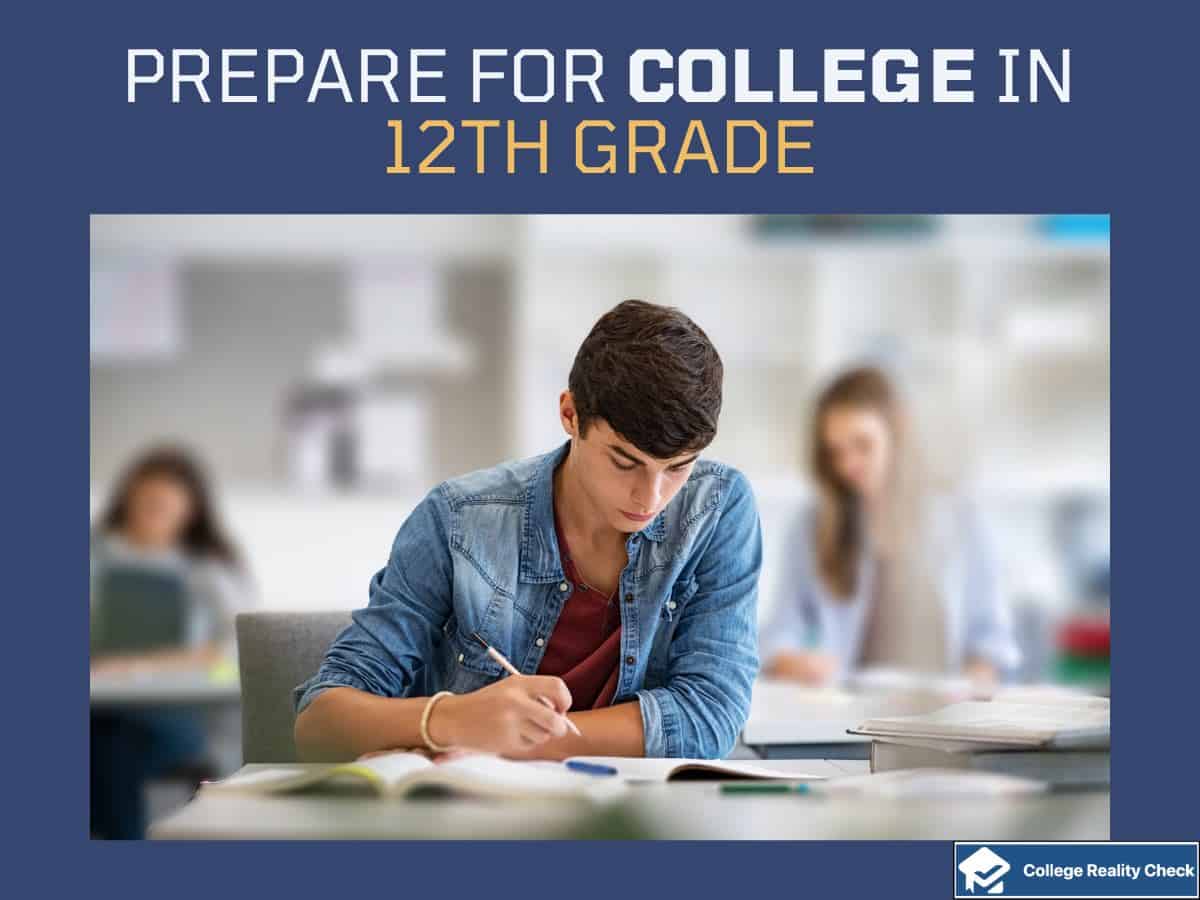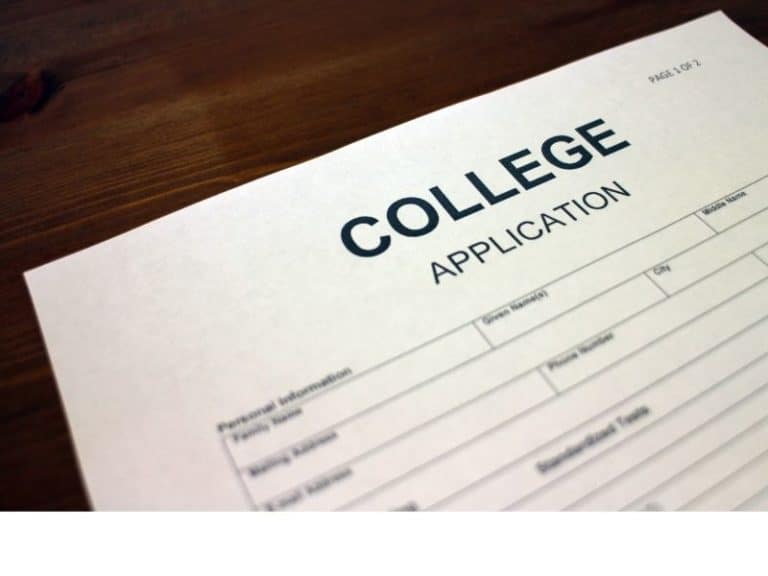How to Prepare for College in 12th Grade
If you are a current high school senior, it is time to plan and apply to colleges. Proper college planning impacts both college acceptance chances and financial aid award opportunities.
Below is the college preparation timeline for 12th graders as well as tips on balancing classes and activities while getting ready for senior year in the most productive way.

1. Keep Grades Up
Because the GPA is the most important role player in the college admissions process and can spell the difference between an acceptance into and a rejection from the top-choice schools of 12th graders, it’s therefore important that they maintain high grades in all subjects to increase their admissions chances.
Each and every grade matters, including those in the 1st and 2nd semesters of the senior year of high school.
Senioritis — it’s characterized by a decline in the motivation of teeners toward the end of their high school careers, as evidenced by a drop in their grades and, of course, their GPAs.
It goes without saying that failure to keep the grade up due to senioritis can put a 12th grade student’s admissions chances in peril.
According to a report by The Princeton Review, while it’s not common for a student accepted by a college of his or her choosing to have his or her offer rescinded, it can happen as a result of a drop in academic performance.
Read Also: How to Prepare for College
2. Remain Involved in Extracurriculars
Extracurricular activities are not as important as other college admissions factors, such as the rigor level of the secondary school record, GPA and standardized test scores.
Yet, it doesn’t mean that it has no significant impact on college decisions — it can serve as a tie-breaker between two hopefuls with similar academic profiles.
Having many different EAs, on the other hand, is not as impactful as having a few meaningful ones, the kinds that 12th graders participate in purposefully and productively, say college admissions officers.
Community involvement and leadership roles are some of the most impressive extracurriculars.
The College Board advises high schoolers to start with EAs as early in their secondary education careers as possible.
It’s a good idea for them to partake in their chosen clubs, organizations and activities sooner to establish their true interests and passions, thus allowing college admissions officers to see what they can potentially contribute to the college campus.
3. Register With the Common App or Coalition App
High schoolers who are thinking about going to college after completing their secondary school may start registering for the Common App or Coalition App even if they don’t plan on applying for another few months or another few years — their accounts, using the same username and password, can rollover from month to month and from year to year.
Because there are more than 1,000 institutions using the Common App and there are a little more than 150 institutions using the Coalition App, chances are that a college-bound teen will have to create an account with any of them.
Some colleges and universities accept both the Common App and Coalition App, while others accept only one. If all institutions on a student’s college list accept one platform and only a few accept the other, it’s a good idea to opt for the application that many employ. Meanwhile, a high schooler should pick the platform he or she is more comfortable with if all colleges accept both.
Some schools, however, have their own application portals.
What’s great about registering with the Common App or Coalition App early is that it allows high school students to familiarize themselves with the entire college admissions process, thus making it less complicated the minute it goes full swing.
4. Narrow Down the College List
The perfect time to take college tours is during the break between the 11th grade and 12th grade, especially since many institutions of higher education begin their fall semester in early August, which allows high schoolers to witness for themselves day-to-day classes and campus activities — and talk with admissions counselors, professors and attendees.
After visiting several ones prior to the start of the senior year of high school, college-bound kids can narrow down their college list to a more manageable length, which can make the college application process less stressful and costly.
It’s important to remember to keep the list well-balanced.
This means that there should be a healthy mix of reach schools (1 to 3), safety schools (1 to 3) and match schools (3 to 5) to increase the chances of at least a single school sending a positive response in the form of an acceptance letter.
12th graders who fail to take in-person campus tours before the start of the school year may consider virtual ones.
5. Write the First Few Drafts of College Essays
It’s at the start of the 12th grade when college-bound students should start creating initial drafts of their college essays while they are not yet swamped with homework, extracurriculars and, of course, various college application-related tasks.
Starting the summer before the senior year of high school, as a matter of fact, is recommended.
Many colleges and universities, including the Ivy Leagues and various selective institutions, require applicants to submit application essays. Since college essays allow admissions officers to get to know applicants on a more personal level, it’s no wonder why it ranks as the 5th most important factor in the college admissions process.
Besides, in some instances, it’s not just a single college essay that graduating high schoolers need to come up with.
Writing anywhere from 12 to 20 essays is not uncommon for some of today’s college applicants, what with all the essay requirements by the Common App or Coalition App, scholarships, specific programs and Honors colleges.
6. Register for the SAT or ACT
When taking the SAT or ACT another time, senior high schoolers should register for the test in September.
According to the College Board, which created and administers the SAT, most students get a higher score the second time they sit for the SAT. Also, most colleges consider an applicant’s highest SAT scores when making a decision.
On the other hand, the ACT, which created and administers the ACT, says that more than 50% of high school students who take the standardized test score another time do better than the first time. It adds, however, that it’s unlikely for a test-taker to significantly improve his or her ACT scores by sitting for it 3 or more times.
Taking the SAT or ACT another time, it’s important to note, isn’t necessary all the time.
High school students who obtained their target SAT or ACT scores — usually the average scores of college-bound teens their top-choice institutions admit — the first time may no longer take the standardized test score again.
7. Register for AP Exams
Another important step most students in their last year of high school must take in September in preparation for their college careers the following year is registering for AP exams.
They may sign up for AP exams for AP classes that they took or for any AP exam of their liking.
Taking both AP classes and AP exams is not really a college application requirement. However, AP classes increase the rigor of secondary school curriculum, which many of the most selective postsecondary institutions take into account. On the other hand, AP exams, particularly high-scoring ones, in many instances, allow students to earn college credits.
Registering for AP exams and getting high scores, too, is a demonstration of college readiness in that applicants get to prove to college admissions officers that they are capable of handling the academic demands of higher education.
8. Take the SAT or ACT One More Time
About a month prior to the test date, registration for the SAT or ACT closes.
Registering for a retake of the SAT or ACT, as mentioned earlier, should be done by senior high schoolers gearing up for college in September, which is a month before the October test date. Even though the registration and test date are just a month apart, students who are sitting for the SAT or ACT again should brush up on concepts and strategies 2 to 3 months early.
It usually takes SAT and ACT scores 2 weeks to be available to those who took them, which is why sitting for the said standardized tests allows students who are planning on applying early to get their hands on their scores on time.
Submitting both scores, if applying to a college that superscores test scores, of course, is a good idea.
10. Ask the Counselor and Teachers for Required Documents
High school counselors and teachers are some of the busiest individuals on any high school campus when junior and senior students start applying to colleges and universities as they are important parts of it.
School report and counselor recommendation — these are created by the high school counselor.
The teacher recommendation, clearly, comes from a 12th grader’s teacher. Different colleges have different rules when it comes to the teacher’s letter of recommendation. Some may want it to be from a teacher of a core subject like English, math, science and history, while others may want it to be from a teacher who taught the applicant in the final 2 years of high school.
Whether the top-choice college wants the school report with a counselor recommendation or a teacher recommendation or both, a college applicant should inform the counselor or teacher at least a month before the deadline.
A week before the deadline strikes, a follow-up should be made, whether via email or in person.
11. Submit Early Application
November is the deadline set by the vast majority of colleges and universities for early applicants — November 1 is the usual deadline for early decision (January 1, on the other hand, is a common deadline for early decision 2), and November 1 and November 15 are the deadlines for early action 1 and early action 2, respectively.
Students should apply ED only if they are willing to commit to the college.
On the other hand, while EA is non-binding like ED, it may still help increase admissions chances, especially if EA applicants have demonstrated an interest in attending the school a number of times.
Applying ED or EA, however, is strongly advised against senior high schoolers who are unhappy with the current state of their college applications and feel that they could use any additional time to improve their GPAs and enhance other application components admissions officers usually consider, including extracurriculars and essays.
12. Submit Regular Decision Application
Around 2 months after early applicants have submitted their applications, it’s the turn of the rest of college-bound teens, which make up the bulk of all college applicants every admissions cycle, to submit theirs.
The majority of regular decision deadlines are in early January, though it can be as late as mid-February at some schools. Usually, 12th grade teens who apply RD hear back from colleges anywhere from mid-March to early April.
Unlike early decision, RD applicants can apply to as many colleges as they like.
It’s just one of the perks that come with applying RD, alongside having the opportunity to retake the SAT or ACT as well as the chance to complete their applications and get their hands on the various required documents or materials. However, applying RD can get in the way of the activities near the end of high school, which can potentially affect a student’s grades.
13. Complete and/or Submit the FAFSA and/or CSS Profile
Starting 2023, the FAFSA form becomes available every December of the year instead of October.
Although the federal deadline for its filing is still June 30, it’s recommended for senior high schoolers to submit the completed form as early as they possibly can. This is especially true for those low-income students who want to get maximum financial aid offers because many institutions of higher education distribute funding in a first-come, first-served manner.
The closer to December the FAFSA is submitted, generally speaking, the higher the chances of a college applicant to be awarded with the highest possible aid and thus pay the least cost of attendance.
It’s true that many colleges use the information on the FAFSA when determining which students are eligible for institutional aid. Some of them, however, also require the filling out of the CSS Profile, which provides access to private financial aid coming not only from the college but from private sources, too.
The CSS Profile, meanwhile, still becomes available on October 1.
14. Compare Financial Aid Offers
The Federal Student Aid, which is an office of the US Department of Education and also the largest provider of financial aid of students in the US, says that college-bound high schoolers who applied to several colleges should compare aid offers to determine which higher education institutions will be most affordable to them.
Most financial aid award letters arrive anywhere from as early as February to as late as May. However, there are also some colleges and universities that send them out as early as November the year before.
In some instances, award letters are sent by schools together with acceptance letters.
Numerous things have to be taken into account when comparing financial aid offers from various schools before graduating high school students make their final decision, and they are listed below:
- Type of financial aid offered
- Amount of renewable financial aid
- Estimated cost of living
- Net cost of attendance — sticker price minus aid and any other funding received
It’s also important for students to note that they can appeal financial aid offers and ask for more money.
15. Take AP Exams
AP exams are administered only once a year, which means that senior high schoolers who wish to take them only have 1 remaining opportunity to do so before they head to college.
During the first 2 weeks of May is when AP exams take place, from Monday to Friday.
The College Board says that 3 out of 4 students who sit for AP exams start pursuing an undergraduate degree with some AP credit, which helps save time and thus allows them to change majors, study abroad or even work on a second degree after completing their first choice.
Generally speaking, colleges look for AP exam scores of 4 or 5 when awarding credits. Some, however, may award credits for AP exam scores of 3, usually depending on the school’s AP credit policy and selectivity level.
Some postsecondary institutions also use AP exams for college placement or only for the said purpose.
16. Notify College of Choice and Pay an Enrollment Deposit
The entire process of preparing for college as a 12th grader usually terminates with the high schooler informing the college that sent the applicant an acceptance letter that he or she is grabbing the offer to enroll.
Such is usually done with an email as well as the putting down of an enrollment deposit.
It’s on May 1 when the vast majority of college-bound teens make their final decision, which is why the said date is commonly referred to as National College Decision Day. Other than RD applicants, EA applicants also have until May 1 to decide which institutions of higher education they will attend.
Some colleges and universities have later dates by which accepted students must make a decision, particularly those that keep accepting applications after most other schools have closed their admissions offices to interested students.
High School Senior Year Checklist for Parents
According to Harvard University, the primary role that parents should play in the college admissions process of their teeners is support. Given that applying to colleges is a particularly stressful and confusing time for high school students, guidance from adults that they can count on is essential for them to stay on the right track.
The following is a checklist of what parents should do when the college application cycle arrives:
- Guide teens in finding their true passion
- Research prospective career outcomes for each major considered
- Encourage the high schooler to examine each college’s programs, physical environment and student life
- Evaluate academic opportunities such as accelerated and study abroad programs
- Accompany their kids in scheduling and taking campus tours
- Proofread college essays and provide constructive feedback on how they can be improved
- Assist the teen in filling out the FAFSA form
- Ensure the safety of information provided by the high schooler when applying for aid
- Facilitate comparison of financial aid offers
- Compute the net price of college — the cost of attendance minus aid
- Understand and discuss the perks of student loans
- Provide gentle reminders and check-ins for every college application-related deadlines
Do Second Semester Senior Grades Matter?
Although the second semester grades of 12th graders won’t necessarily impact their college admissions chances because they have likely received them by the time they have heard back from the colleges to which they applied, college admissions officers will still make sure that their admits have kept their GPAs high, thus ending their secondary education careers strong.
When is the FAFSA Deadline?
The FAFSA deadline is June 30, although students who are applying for financial aid are encouraged to fill out and submit the FAFSA as close to December, the date the form becomes available, as possible. However, it’s important to point out that the federal deadline is the latest FAFSA deadline, which means that college and state FAFSA deadlines are earlier.
Disclaimer: The views and opinions expressed in this article are those of the authors and do not necessarily represent those of the College Reality Check.






